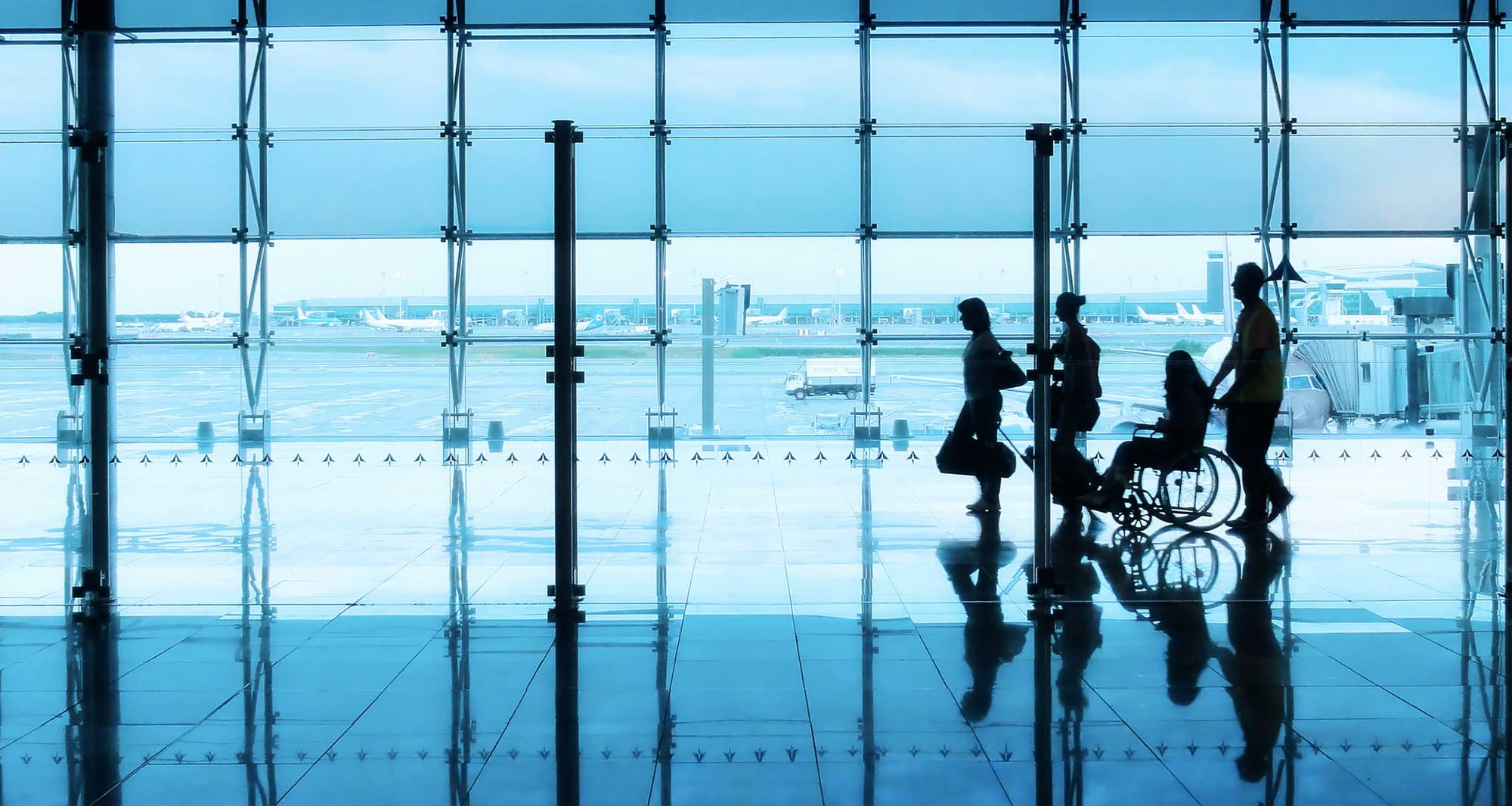
What are my rights under the Air Carrier Access Act?
The Air Carrier Access Act of 1986 (ACAA) was designed to prohibit any discrimination against passengers with disabilities by air carriers. It was meant to open the skies and the world to persons regardless of any physical or intellectual disabilities. Although I believe there is a great deal of work that must be done to enforce the law, it has still improved the way travelers with disabilities are treated. The ACAA has made air travel possible for people like me, a triple amputee and wheelchair user. The specific rights of disabled air passengers were outlined by the U.S. Department of Transportation in 1990 in 14 CFR Part 382. The guidelines were most recently updated in 2008, and changes took effect in May 2009.
Travelers should note that the Air Carrier Access Act is a law of the United States of America. The rights and protections outlined here do not apply to all flights in the world. The law applies only to the following flights:
- Any flight departing from an airport in the United States, regardless of carrier.
- Any flight arriving to an airport in the United States, regardless of carrier.
- Any flight operated by an air carrier registered in the United States of America – this includes flights between two international destinations. For example, a United Airlines flight between Hong Kong and Singapore would be subject to the ACAA, because United Airlines is a U.S. flagged carrier.
Regarding international air carriers: The ACAA would NOT apply to a British Airways flight between London and Paris, but would on a British Airways flight between London and New York City or vice versa. The European Union has also outlined the rights of disabled airline passengers in Europe.
For a full copy of 14 CFR Part 382, visit www.ecfr.gov. I have written a summary of the most important components of the Air Carrier Access Act below. This summary describes the responsibilities of airlines and the expectations for passengers with disabilities traveling by air.
(adsbygoogle = window.adsbygoogle || []).push({});
Assistance at the Airport and Onboard the Airplane
Airlines must provide travelers with disabilities with the following assistance at the airport, if requested by the passenger:
- Carriers shall provide assistance…in emplaning and deplaning. The delivering carrier shall be responsible for assistance in making flight connections and transportation between gates. § 382.39 (a)
- This assistance shall include…the services personnel and the use of ground wheelchairs, on-board wheelchairs…and ramps or mechanical lifts. § 382.39 (a) (1)
- Carriers must offer preboarding to passengers with disabilities who self-identify at the gate as needing additional time to board. In a March 2013 notice to airlines, carriers were advised by the DOT that preboarding means “before all other passengers, including first class passengers, elite-level passengers, members of the military, passengers with small children, etc.” § 382.93
- Carriers shall not leave a passenger with a disability unattended in a ground wheelchair, boarding wheelchair, or other device, in which the passenger is not independently mobile, for more than 30 minutes. § 382.39 (a) (3)
Airlines must also provide services onboard the aircraft (on the ground and inflight), to passengers with disabilities, whether they are non-ambulatory or semi-ambulatory:
- Assistance in moving to and from seats, as part of the enplaning and deplaning processes. § 382.39 (b) (1)
- Assistance in preparation for eating, such as opening packages and identifying food. § 382.39 (b) (2)
- If there is an on-board wheelchair on the aircraft, assistance with the use of the on-board wheelchair to enable the person to move to and from a lavatory. § 382.39 (b) (3)
- Assistance in loading and retrieving carry-on items, including mobility aids and other assistance devices stowed on board. § 382.39 (a) (5)
(adsbygoogle = window.adsbygoogle || []).push({});
Transportation of Personal Wheelchairs and Mobility Equipment
Airlines are required to provide free and safe transportation for the personal wheelchairs and mobility devices of passengers with disabilities, in accordance with § 382.121 and § 382.123.
Wheelchairs may be of any size or weight, so long as they will fit into the wheelchair storage closet in the aircraft cabin, or inside the aircraft cargo compartment. For information on storing wheelchairs in the aircraft cabin, see § 382.121.
According to § 382.125(c), airlines must allow for the checking and timely return of wheelchairs at the boarding gate:
You must provide for the checking and timely return of passengers’ wheelchairs, other mobility aids, and other assistive devices as close as possible to the door of the aircraft, so that passengers may use their own equipment to the extent possible…
The passenger has the right to reclaim a gate-checked wheelchair at baggage claim instead of at the arriving gate, if he/she so desires. The delayed return of gate-checked wheelchairs arises for a number of reasons, and is almost always a violation of of § 382.125.
Should an airline damage your wheelchair, the ACAA places total liability on the carrier, regardless of cost. I have previously had a $25,000 wheelchair replaced after it was destroyed by Delta Air Lines.
(adsbygoogle = window.adsbygoogle || []).push({});
Accessibility features of aircraft
Commercial aircraft with more than 30 seats must adhere to the following requirements and provide the listed design and accessibility features:
- At least one-half of all aisle seats must have a movable aisle armrest. § 382.21 (a) (1)
- Seating with movable aisle armrests must be made available to persons with disabilities who require them § 382.21 (a) (1)
For aircraft with more than 100 seats:
- A priority space in the cabin must be reserved for the stowage of at least one folding wheelchair. § 382.21 (a) (2)
- Aircraft with more than one aisle should provide at least one lavatory accessible via an on-board aircraft wheelchair. The lavatory must provide door locks, call buttons, grab bars, faucets and other controls accessible to a person with a disability, including those who entered by means of the on-board wheelchair. § 382.21 (a) (3)
- All aircraft with an accessible lavatory and more than 60 seats must be equipped with an on-board aisle wheelchair. § 382.21 (a) (4)
- Passengers requiring use of the on-board wheelchair for access to the lavatory must receive assistance in the maneuvering (pushing, pulling, turning) of the wheelchair by carrier personnel. Flight attendants are not required to provide assistance in lifting the passenger from the seat to aisle chair or from the aisle chair to lavatory toilet. § 382.21 (a) (4)
(adsbygoogle = window.adsbygoogle || []).push({});
Accessibility of airport facilities
The Air Carrier Access Act requires the following of airport facilities:
- An accessible path must be available between the gate and the area from which aircraft are boarded. § 382.23 (c)
- Inter-terminal shuttles and people movers must be wheelchair accessible. § 382.23 (d)
Notifying airlines of needed services
Except under the following conditions, a disabled passenger is not required to provide advance notice to an airline about their intent to travel, their disability, or any service accommodations needed.
- In accordance with § 382.33, a carrier may require up to 48 hours advance notice and one-hour advance check-in for any individuals who wish to receive the following services, types of equipment, or accommodations:
- Medical oxygen for use on board the aircraft during flight.
- Carriage of an incubator.
- Hook-up for a respirator to the aircraft electrical power supply.
- Accommodations for a passenger who must travel in a stretcher.
- Transportation for an electric wheelchair or scooter on a flight scheduled to be made on an aircraft with less than 60 seats.
- Provision by a carrier of hazardous materials packaging for the batteries of an electric wheelchair or scooter, if necessary.
- Provision of an on-board wheelchair on aircraft with less than 100 seats which do not have an accessible lavatory.
It is still recommended that passengers notify the airline in advance for any need when possible, whether required by this section or not.
Care attendants
Except in very limited circumstances, aircraft carriers cannot require a disabled person to travel with a personal care attendant as a condition of being provided air transportation. A carrier’s concern that a disabled passenger will require the use of an inaccessible lavatory or may otherwise need extensive special assistance are not grounds for requiring an attendant. § 382.35 (a)
The following exceptions to this rule are provided when the carrier believes that an attendant is necessary for safety:
- A person traveling in a stretcher or incubator. § 382.35 (b)(1)
- A person who, because of a mental disability, is unable to comprehend or respond to safety instructions. § 382.35 (b)(2)
- A person with a mobility impairment so severe that the person is unable to assist in his or her own evacuation of the aircraft. § 382.35 (b)(3)
- A person with hearing and vision impairments so severe that the person cannot receive or understand safety instructions. § 382.35 (b)(4)
If the carrier determines that a person meeting the criteria of paragraph (b)(2), (b)(3) or (b)(4) of this section must travel with an attendant, contrary to the individual’s self- assessment that he or she is capable of traveling independently, the carrier shall not charge for the transportation of the attendant. § 382.35 (c)
If a seat is not available for the attendant required by the airline and the ticketed passenger is unable to travel on the flight, the person with a disability shall be eligible for denied boarding compensation as per 14 CFR part 250.
Service animals and emotional support animals
Airlines must permit passengers with a disability to travel with a service animal. § 382.117 (a)
The DOT defines a service animal as “any animal that is individually trained or able to provide assistance to a person with a disability; or any animal that assists persons with disabilities by providing emotional support.” Different regulations apply to the carriage of each, so, for the purposes of clarity I will refer to them as “trained service animals” and “emotional support animals.”
All of the following are acceptable forms of evidence that an animal is indeed a trained service animal § 382.117 (d):
- Credible verbal assurances of a qualified individual with a disability using the animal.
- Identification cards or other written documentation.
- Harnesses or tags to indicate the animal’s status.
Airlines may not require passengers to provide advance notice of their intent to travel with a trained service animal, except when traveling on a flight segment scheduled to last 8 hours or more. § 382.117 (a)(2)
An advance notice requirement of 48 hours or more may be imposed on passengers traveling with an emotional support animal. Airlines may require documentation from a licensed mental health professional. § 382.117 (e)
Unusual service animals, including snakes, reptiles, ferrets, rodents, spiders, etc., are not protected by the Air Carrier Access Act, and may be refused by the air carrier. Foreign air carriers are not required to transport any service or emotional support animals other than dogs. § 382.117 (f)
Additionally, under the following circumstances, an airline is within its rights to deny either a trained service animal or an emotional support animal § 382.117 (f):
- The animal is too large or heavy to be accommodated safely in the aircraft cabin.
- The animal may pose a direct threat to the health or safety of others.
- The animal would cause a significant disruption to cabin service.
- The animal would be prohibited from entering the foreign country of the flight’s destination.
- The animal exhibits unacceptable behavior including: urinating in non-designated relief areas, running around or jumping onto other passengers, barking at other passengers without provocation or for a reason unrelated to its function as a service animal.
According to § 382.117 (g), if for any reason an air carrier refuses to transport a service animal, the airline must provide a written explanation of the decision to the passenger within 10 calendar days of the refusal. If your service animal is denied carriage, you may submit a complaint to the U.S. Department of Transportation, who will investigate and determine if a violation occurred.



